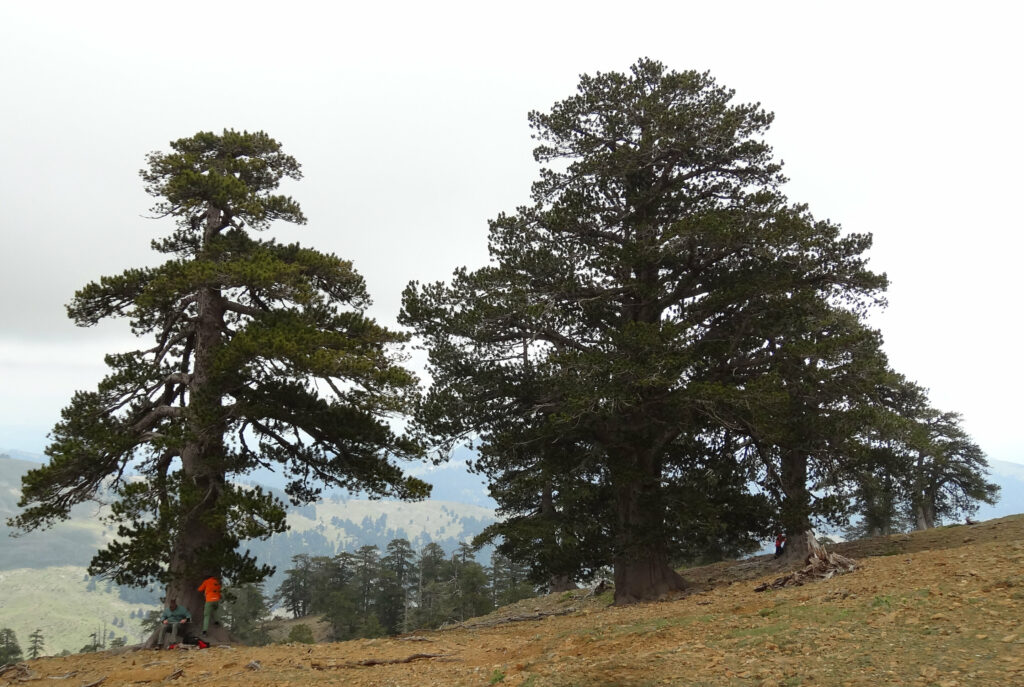Wood samples from the Balkan region were among those analyzed for this study. Credit: Valerie Trouet
Measurements of the jet stream have only been around since the late 1940s, Trouet said. By using tree-ring samples from across Europe as proxies for temperature, the research team was able to reconstruct jet stream variation over the past 700 years.
Each year, trees add a ring consisting of less dense wood in the spring and denser wood in the summer. By analyzing tree rings under the microscope, dendrochronologists can compile an archive of past climates.
“We link tiny, subcellular cell wall features in the wood to atmospheric winds that weave through the atmosphere many miles above the Earth, which is fascinating,” Trouet said.
Remarkably, the team found past patterns of the jet stream reflected on a societal level, recorded in historical documents.
“Europe has a long history of writing things down,” Trouet said. “For example, there were monks in Ireland who started recording storms that happened in the 600s, the early Middle Ages, and you have centuries-long records of grape harvests, grain prices and epidemics.”
By comparing historical records to the jet stream reconstruction, Trouet’s team discovered that the climate dipole created by the jet stream has influenced European society for the past 700 years and likely much longer.
“Epidemics happened more frequently in the British Isles when the jet stream was further north,” Trouet said. “Because summers were wet and cold, people stayed indoors, and the conditions were more conducive to spreading diseases.”
From 1348 to 1350, the plague, known as the Black Death, raged in Ireland. At that time, the jet stream was in an extreme, far-north position over Europe.
In Scotland, where virtually no living trees going back many hundreds of years are left, the team collected subfossil wood from lake bottoms for dendrochronological analysis in the lab. Credit: Valerie Trouet
The findings provide critical data to improve climate models that researchers rely on to predict future climate, Broadman said. Much research has focused on how the jet stream is affected as a result of global warming.
“It’s hard to do that if you only have 60 years’ worth of data, which is why a reconstruction going back 700 years is very useful,” she said. “It allows you to actually compare the past to what’s been happening since we started putting greenhouse gases into the atmosphere.”
Harvest failures, wildfires and extreme weather
Scientists have observed a trend showing the jet stream is gradually shifting northward, independent of its seasonal or more short-term variations.
“When you combine our reconstruction with harvest failures, you see that this trend likely leads to issues with major cereal crops and other types of weather extremes,” Trouet said. “It gives you a preview of the kinds of extreme events and societal outcomes we could expect if that trajectory continues.”
The findings also set a precedent for a future trajectory of jet stream variation and extreme weather events, such as wildfires, Trouet said.
“We showed that wildfires in the Balkans historically happened substantially more when the jet stream was in that northern position that creates dry and hot conditions,” she said. “And that is exactly what we’re seeing this summer. The results that we’re seeing in our reconstruction act out in real life.”
“When you look at how the jet stream’s natural variability alone has impacted societies, you can get an idea of what might happen if you add more heat in the atmosphere and more variability,” Broadman added. “Being able to say, ‘OK, maybe we need to watch out for this or that particular jet stream configuration’ can be very helpful for predictions of climate-related extremes.”
More information:
Valerie Trouet, Jet stream controls on European climate and agriculture since 1300 CE, Nature (2024). DOI: 10.1038/s41586-024-07985-x. www.nature.com/articles/s41586-024-07985-x
Provided by
University of Arizona
Citation:
Tree-ring data reveal how the jet stream has shaped extreme weather in Europe for centuries (2024, September 25)
retrieved 25 September 2024
from https://phys.org/news/2024-09-tree-reveal-jet-stream-extreme.html
This document is subject to copyright. Apart from any fair dealing for the purpose of private study or research, no
part may be reproduced without the written permission. The content is provided for information purposes only.
Source link : http://www.bing.com/news/apiclick.aspx?ref=FexRss&aid=&tid=66f42972aeb54c7eaec67b40dba80971&url=https%3A%2F%2Fphys.org%2Fnews%2F2024-09-tree-reveal-jet-stream-extreme.html&c=12112274888916703254&mkt=de-de
Author :
Publish date : 2024-09-25 08:00:00
Copyright for syndicated content belongs to the linked Source.
